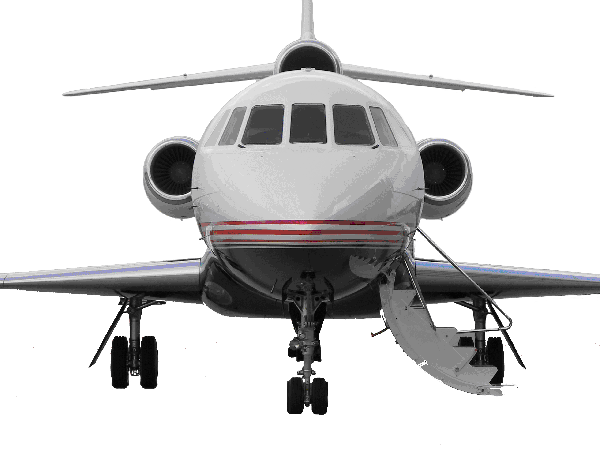
November 1996
We departed for St. Vincent on Friday 22 November and flew to St.
Vincent. We planned two one-week sails with a change of crew after the first
week. The first week sail included Bequia, Mustique, Canouan, and the Tobago
Cays. Three catamarans with Doug Rapkine, Tom Guthrie, and myself as
skipper. The second week sail included the western coast of St. Vincent,
bequia, Canouan, and the Tobago Cays. Only one catamaran with myself as
skipper. The float plan for the second week was much more relaxed than the
first week. The weather was consistently perfect with winds from the east
between 15 and 18 knots, sun shine with an occasional cloud, and slight seas
2 to 4 feet. Some of the crew was delayed a day due to bad airline
connections but we all were aboard by Saturday afternoon. We made final
preparations to get underway early Sunday morning.
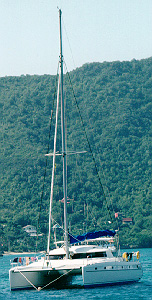 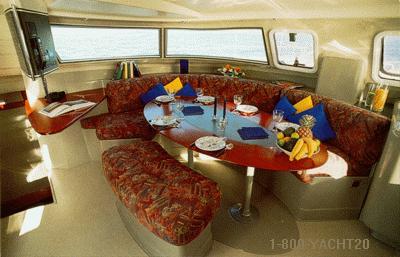 We
chartered three Fountaine Pajots - one 42' and two 38' cruising catamarans.
They were quite comfortable and fast. Each boat had four cabins and
plenty of deck space. The each had two engines, a dinghy with
outboard, and held plenty of fresh water. We had eight people on each of the
38' boats and nine on the 42' boat as there were some small single birth
quarters in for forward part of the hull. The galley and saloon were large
compared with sloops and there was an added advantage of a large cockpit and
fore deck. The boats were comfortable and fast as we reached 9.8 knots in a
28 knot wind on a beam reach. The interior was well laid out with a
head in each hull. A swim platform on the stern was the most popular
place to shower after swimming each afternoon. The large decks were
excellent for entertaining and the cockpit provided ample room for dining. We
chartered three Fountaine Pajots - one 42' and two 38' cruising catamarans.
They were quite comfortable and fast. Each boat had four cabins and
plenty of deck space. The each had two engines, a dinghy with
outboard, and held plenty of fresh water. We had eight people on each of the
38' boats and nine on the 42' boat as there were some small single birth
quarters in for forward part of the hull. The galley and saloon were large
compared with sloops and there was an added advantage of a large cockpit and
fore deck. The boats were comfortable and fast as we reached 9.8 knots in a
28 knot wind on a beam reach. The interior was well laid out with a
head in each hull. A swim platform on the stern was the most popular
place to shower after swimming each afternoon. The large decks were
excellent for entertaining and the cockpit provided ample room for dining.
|
Echo |
Amis De La
Mer |
Moonbeam |
| John Beck |
Tom Guthrie |
Doug Rapkine |
| Bob Bennett |
Tom McLoughlin |
Nabi Rafie |
| Bob Bell |
Stan King |
Michael Christoff |
| Stephanie Bell |
Bill McGinniss |
Jeff Parrish |
| Ian Bell |
Laura Herkert |
Brian Boyer |
| Mike McCarthy |
Cindy Humphrey |
Amy Taylor |
| Rachelle McCarthy |
Diane Coogan |
Joan Most |
| Martha Fratt |
Dionne Wenke |
Sharon DeVries |
| Norm Belson |
|
|
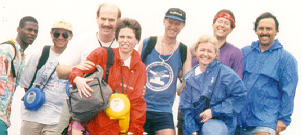 The Second Week Crew aboard Echo was lost at sea shortly
before their scheduled end date. A week later, this photograph was found
washed ashore on Trinadad. Reports from local fisherman say they saw a
ghost ship that fit the description heading south toward Rio with loud music
playing and several fishing lines towed behind. People were reported dancing
on deck along with a few native-looking people who apparently joined the
party. The owners of the boat are also reported missing as they are
believed to have joined the crew in their irresponsible frolicking in the
Caribbean. The vessel will be missed by the charter company as it was
(and is) a fine ship and the crew a favorite customer of the base operator.
No photographs or evidence of survivors have been documented and tales from
locals cannot be validated because the ship is reported simultaneously in
several places when it appears. A Budwiser spinnaker has been seen on the
ghost ship though none was put aboard, claims the charter company. Those
reported missing include Bob Bennet, First Mate, Steve Krapes, Stina Ross,
John Beck, Captain, Cathy Lavelle, Ramon Caceres, and Nabi Rafie. - reprint
from UPI. The Second Week Crew aboard Echo was lost at sea shortly
before their scheduled end date. A week later, this photograph was found
washed ashore on Trinadad. Reports from local fisherman say they saw a
ghost ship that fit the description heading south toward Rio with loud music
playing and several fishing lines towed behind. People were reported dancing
on deck along with a few native-looking people who apparently joined the
party. The owners of the boat are also reported missing as they are
believed to have joined the crew in their irresponsible frolicking in the
Caribbean. The vessel will be missed by the charter company as it was
(and is) a fine ship and the crew a favorite customer of the base operator.
No photographs or evidence of survivors have been documented and tales from
locals cannot be validated because the ship is reported simultaneously in
several places when it appears. A Budwiser spinnaker has been seen on the
ghost ship though none was put aboard, claims the charter company. Those
reported missing include Bob Bennet, First Mate, Steve Krapes, Stina Ross,
John Beck, Captain, Cathy Lavelle, Ramon Caceres, and Nabi Rafie. - reprint
from UPI.
Navigation was easy as all the islands are clearly visible and close
together. Bequia is about 8 miles from St. Vincent, Mustique 8 miles from
Bequia, and Canouan another 8 miles. The Tobago Cays are only a few miles
from Canouan. Visibility on the water is typically 17 miles. There are
only a few dangerous reefs and the ocean is usually deep close to shore. Our
first stop was Bequia which could be easily seen from the entrance to Blue
Lagoon and a beam reach as the prevailing winds are from the east. A typical
day was 85 degrees with a 17 knot wind from the east and seas 1 to 3 feet.
Perfect for pleasure sailing. We did have an occasional shower and only one
day of clouds and rain. Our average boat speed was 6 to 7 knots in a 17 knot
wind on a beam reach though our fastest speed was just under ten knots in a
25 knot wind.
Bequia
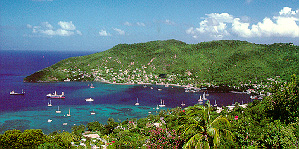 Bequia
is about 9 miles south of St. Vincent and is the largest of the
Grenadines. It retains old traditions of boat building, whaling, and
fishing. Admiralty Bay is a natural harbor and a favorite spot.
The island is blessed with gold sand beaches and coves. The quaint
little town at the head of Admiralty Bay is picturesque and has many small
shops and restaurants selling batik, jewellery, and crafts. Bequia
is about 9 miles south of St. Vincent and is the largest of the
Grenadines. It retains old traditions of boat building, whaling, and
fishing. Admiralty Bay is a natural harbor and a favorite spot.
The island is blessed with gold sand beaches and coves. The quaint
little town at the head of Admiralty Bay is picturesque and has many small
shops and restaurants selling batik, jewellery, and crafts. 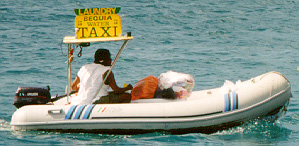 Natives often come
visit in their small boats offering fruit and vegetables or local crafts of
which some are quite nice. A water taxi is available to help crew
members and passengers get to shore when their dinghy is in use. Ashore the
natives are friendly. Provisions and dinghy fuel can be purchased near the
town dock making the dinghy ride with food relatively easy compared to the
other islands, including St. Vincent. There is an amazing builder of
model sail boats ranging in size of up to four or five feet (each visit I
come closer to buying) though some are as much as $1,000 US. A hike to the
fort overlooking the entrance to the bay is recommended. Many people enjoyed
our little Moke (micro pickup truck) tour of the island. The unspoiled
scenery of Hope Bay is inaccessible except by foot and was a major
attraction for those who made the hike. The best snorkeling is at Table Rock
near the entrance to Admiralty Bay. Coco's is a good restaurant. Natives often come
visit in their small boats offering fruit and vegetables or local crafts of
which some are quite nice. A water taxi is available to help crew
members and passengers get to shore when their dinghy is in use. Ashore the
natives are friendly. Provisions and dinghy fuel can be purchased near the
town dock making the dinghy ride with food relatively easy compared to the
other islands, including St. Vincent. There is an amazing builder of
model sail boats ranging in size of up to four or five feet (each visit I
come closer to buying) though some are as much as $1,000 US. A hike to the
fort overlooking the entrance to the bay is recommended. Many people enjoyed
our little Moke (micro pickup truck) tour of the island. The unspoiled
scenery of Hope Bay is inaccessible except by foot and was a major
attraction for those who made the hike. The best snorkeling is at Table Rock
near the entrance to Admiralty Bay. Coco's is a good restaurant.
Mustique
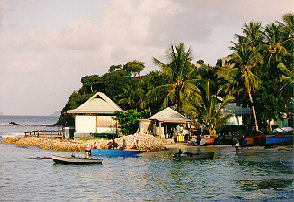 Mustique is south of Bequia and an easy two hour sail. It measures
only 3 by 1.5 miles and is privately owned. It is a well manicured
island with rolling green hills and white sand beaches that blend into the
turquoise waters. The islands only resort is the Cotton House which was
converted
Mustique is south of Bequia and an easy two hour sail. It measures
only 3 by 1.5 miles and is privately owned. It is a well manicured
island with rolling green hills and white sand beaches that blend into the
turquoise waters. The islands only resort is the Cotton House which was
converted 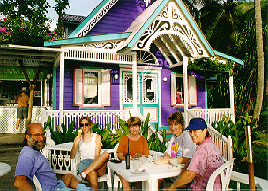 from a large 18th century plantation house. Many attractive villas,
including those owned by celebrities, are available for rental. The
Firefly offers rooms for rent and is our favorite restaurant on the island.
Though, Basil's is comparably priced with similar food, there's just
something special about the Firefly that can only be discovered by a
visit.The best place to anchor is in the middle of the bay, close to shore,
just south of the dock in about 14 feet of water. It's quiet, near the
dinghy dock, and well protected from the wind. The best place to eat is the
Firefly. The best snorkeling is right by the boats. The town is fun to
explore and there are fishermen in the town center who prepare their
daily catch for the restaurants and residents. Horseback riding is available
on the island. There is an excellent road that goes around the island
which takes a few hours to walk. The beaches are beautiful. We spent
little time in Mustique though we recommend walking the island, visiting the
beaches, and snorkeling. An early morning walk around the island is
great exercise. The main street is quite colorful with a few
interesting shops and boutiques.
from a large 18th century plantation house. Many attractive villas,
including those owned by celebrities, are available for rental. The
Firefly offers rooms for rent and is our favorite restaurant on the island.
Though, Basil's is comparably priced with similar food, there's just
something special about the Firefly that can only be discovered by a
visit.The best place to anchor is in the middle of the bay, close to shore,
just south of the dock in about 14 feet of water. It's quiet, near the
dinghy dock, and well protected from the wind. The best place to eat is the
Firefly. The best snorkeling is right by the boats. The town is fun to
explore and there are fishermen in the town center who prepare their
daily catch for the restaurants and residents. Horseback riding is available
on the island. There is an excellent road that goes around the island
which takes a few hours to walk. The beaches are beautiful. We spent
little time in Mustique though we recommend walking the island, visiting the
beaches, and snorkeling. An early morning walk around the island is
great exercise. The main street is quite colorful with a few
interesting shops and boutiques.
Tobago Cays
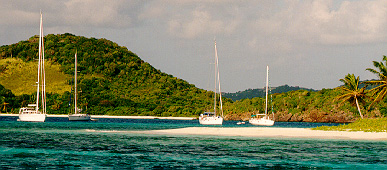 The
Tobago Cays are just south of Canouan and an easy two and a half hour
sail from Bequia. The Tobago Cays are rare tropical paradise with numerous
islets and coves guarded by some of the most spectacular coral reefs in the
world. Our anchorage here was the highlight of our trip as it is a major
attraction for all of us. There is an excellent anchorage just east of Baradel Island
where the water is just shallow enough to intimidate sloops yet plenty deep
for the shallow draft of cruising catamarans. The bottom is sand and
excellent holding. Since the area is a national park, they do not allow
anybody to live there either on shore or aboard boats. Consequently, the
islands have no houses and are natural and clean. Excellent snorkeling is a
short swim away and an underwater marine park just on the other side of
Horseshoe Reef bears the name "Tobago Cays Underwater Marine
Park." Boat boys will like up behind your boat awaiting their
turn to show you T-shirts, crafts, fruit, vegetables, and a variety of
locally made art. The
Tobago Cays are just south of Canouan and an easy two and a half hour
sail from Bequia. The Tobago Cays are rare tropical paradise with numerous
islets and coves guarded by some of the most spectacular coral reefs in the
world. Our anchorage here was the highlight of our trip as it is a major
attraction for all of us. There is an excellent anchorage just east of Baradel Island
where the water is just shallow enough to intimidate sloops yet plenty deep
for the shallow draft of cruising catamarans. The bottom is sand and
excellent holding. Since the area is a national park, they do not allow
anybody to live there either on shore or aboard boats. Consequently, the
islands have no houses and are natural and clean. Excellent snorkeling is a
short swim away and an underwater marine park just on the other side of
Horseshoe Reef bears the name "Tobago Cays Underwater Marine
Park." Boat boys will like up behind your boat awaiting their
turn to show you T-shirts, crafts, fruit, vegetables, and a variety of
locally made art. 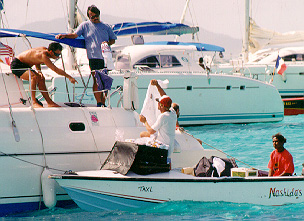 I found the tiki pendant I had been wanting since my last trip
to the Cays so I settled down with a cup of tea ready for a long negotiation
to get the price I wanted and found it was only a matter of minutes before
my desires were met. They enjoy a good negotiation. The boat boys are
interesting and often have fun jewelry carved from coral and ivory.
The T-shirts are cool and made from good material. I found the tiki pendant I had been wanting since my last trip
to the Cays so I settled down with a cup of tea ready for a long negotiation
to get the price I wanted and found it was only a matter of minutes before
my desires were met. They enjoy a good negotiation. The boat boys are
interesting and often have fun jewelry carved from coral and ivory.
The T-shirts are cool and made from good material. 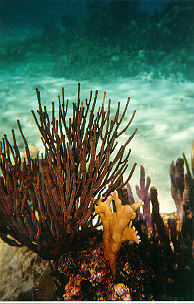 We stayed here for
three days and two nights which was long enough to really relax but not too
long that we got bored. There is a barrier reef and an underwater national
park. It's easy to navigate and the ultimate in tropical paradise. The
Tobago Cays are a good place to write post cards, read a book, snorkel,
perhaps dive, and write. Snorkeling is perhaps some of the best in
the Caribbean if not the world. We do have a favorite coral garden in Bora
Bora so classifying it as in the top 5% would be a safe bet. The acres and
variety of coral in water from a few feet to sixty feet are perfect for both
snorkeling and scuba diving. Some of the best coral was quite close to the
boat making access embrassingly easy. The warm water, bright colors, and
large schools of fish was impressive. Our favorite time to snorkel was at
noon when the light was the brightest. We stayed here for
three days and two nights which was long enough to really relax but not too
long that we got bored. There is a barrier reef and an underwater national
park. It's easy to navigate and the ultimate in tropical paradise. The
Tobago Cays are a good place to write post cards, read a book, snorkel,
perhaps dive, and write. Snorkeling is perhaps some of the best in
the Caribbean if not the world. We do have a favorite coral garden in Bora
Bora so classifying it as in the top 5% would be a safe bet. The acres and
variety of coral in water from a few feet to sixty feet are perfect for both
snorkeling and scuba diving. Some of the best coral was quite close to the
boat making access embrassingly easy. The warm water, bright colors, and
large schools of fish was impressive. Our favorite time to snorkel was at
noon when the light was the brightest. 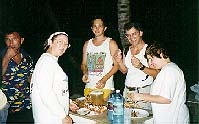 For three days, we planned our day's
activities around our two hour snorkeling beginning just before noon. The
rest of the day was filled with doing little or not much at all though the
days did fill up quickly. Any worries of life back home seem so
insignificant. A close second to snorkeling was wind surfing as the constant
breeze from the east and the warm water made the sail board quite popular.
Two nights is about right and would be good for an annual visit. One night
we had a lobster barbeque on the beach. We bought the lobsters from a
boat boy and gave them some butter. They first boiled the lobsters and then
grilled them basting them in the butter and melted some for out dining
pleasure. After dinner we walked up a small hill and watched the moon rise
over a calm ocean with our yachts below. A night to remember! For three days, we planned our day's
activities around our two hour snorkeling beginning just before noon. The
rest of the day was filled with doing little or not much at all though the
days did fill up quickly. Any worries of life back home seem so
insignificant. A close second to snorkeling was wind surfing as the constant
breeze from the east and the warm water made the sail board quite popular.
Two nights is about right and would be good for an annual visit. One night
we had a lobster barbeque on the beach. We bought the lobsters from a
boat boy and gave them some butter. They first boiled the lobsters and then
grilled them basting them in the butter and melted some for out dining
pleasure. After dinner we walked up a small hill and watched the moon rise
over a calm ocean with our yachts below. A night to remember!
St. Vincent
St. Vincent is a small, 130 square mile island with a population of
115,000 people. It's 18 miles long and 11 miles wide. The 4,000' volcano, La
Soufrier, gives the island northern half a distinctivly bold and virile
character. Thick tropical rain forest, bamboo and fern valleys, extrsions of
eroded lava moonscapes, torn black cliffs pounded by silvered surf. Hidden
waterfalls, hot volcanic springs, Indian petroglyphs all make for a
playground for intrigue. The rugged eastern coast is lined with cliffs and
rocky shores while the western c oastline dips sharply down into black and
gold sand beaches. The rich volcanic soil produces an abundance of fruits,
vegetables and spices, such as coconuts, bananas, breadfruit, nutmeg, and
arrowroot.
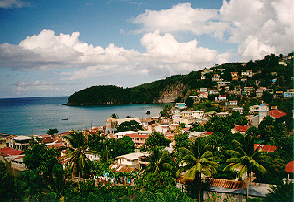 The towns
along the coast support a majority of the population. The capital of
St. Vincent and the Grenadines is the town of Kingstown situated on the
southwest coast of the island. There are two major banks - Bank of
Nova Scotia and Barclays Bank PLC. Branches in the other islands make
accessing the Eastern Caribbean currency easy. There are several other
towns, each of which is unique. In Kingstown there are markets, industry,
businesses, government, shops, churches, and a variety of restaurants. The
best buys are te batik and screen printed items, locally made handicrafts,
leather craft and wood carvings. The botanical gardens has a wide variety of
tropical plants where they conserve rare species since 1765. The towns
along the coast support a majority of the population. The capital of
St. Vincent and the Grenadines is the town of Kingstown situated on the
southwest coast of the island. There are two major banks - Bank of
Nova Scotia and Barclays Bank PLC. Branches in the other islands make
accessing the Eastern Caribbean currency easy. There are several other
towns, each of which is unique. In Kingstown there are markets, industry,
businesses, government, shops, churches, and a variety of restaurants. The
best buys are te batik and screen printed items, locally made handicrafts,
leather craft and wood carvings. The botanical gardens has a wide variety of
tropical plants where they conserve rare species since 1765. 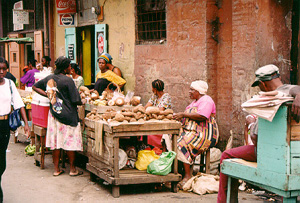 These are the
oldest Botanical Gardens in the Western hemisphere. The gardens contain the
original breadfruit tree brought by Captain Blight (of the Bounty fame) in
1793. The coastal towns are home for the natives and the few expansive
estates and plantations grow bananas - the islands cash crop. Kingstown
Center consists of twelve small blocks with lots of shops selling local
crafts, cameras, binoculars, watches, perfumes, jewellery, and things. But,
we enjoyed the fish market and the vegetable market the best. It is a
lively place with men and women of all ages selling their fruits and
vegetables right on the street. They set up their stands and spread
out on the street and sell food at a most reasonable price. These are the
oldest Botanical Gardens in the Western hemisphere. The gardens contain the
original breadfruit tree brought by Captain Blight (of the Bounty fame) in
1793. The coastal towns are home for the natives and the few expansive
estates and plantations grow bananas - the islands cash crop. Kingstown
Center consists of twelve small blocks with lots of shops selling local
crafts, cameras, binoculars, watches, perfumes, jewellery, and things. But,
we enjoyed the fish market and the vegetable market the best. It is a
lively place with men and women of all ages selling their fruits and
vegetables right on the street. They set up their stands and spread
out on the street and sell food at a most reasonable price. 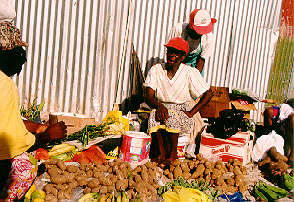 It's a colorful
place with a lot of negotiating happeing and it's just a lot of fun. People
are very friendly. Here, you will see no food wrappers, little plastic, no
check-out lines, and no spoiled food. The food is very fresh and healthy.
The quality is as good as a gourmet grocery back home with the prices lower
than anything you've ever seen. It would be a great place to buy provisions
for the boat; however, they are not likely to stay fresh for any voyage. We
bought a young coconut and the woman cut the top off with a machetti to form
a natural glass. Ramon started to drink it though thought it wasn't
quite perfect. The woman sensed a hint of dissatisfaction and
immediately took it from him almost wrestling it from his had. Since
she had a big knife, Ramon watched patiently as she hacked another cup full
of young coconut milk for him quickly. It's a fun place. You'd like it. Fort
Charlotte was completed in 1806 on a ridge 600 ' above the sea with a
magnificent view across Kingstown and the Grenadines. It's a colorful
place with a lot of negotiating happeing and it's just a lot of fun. People
are very friendly. Here, you will see no food wrappers, little plastic, no
check-out lines, and no spoiled food. The food is very fresh and healthy.
The quality is as good as a gourmet grocery back home with the prices lower
than anything you've ever seen. It would be a great place to buy provisions
for the boat; however, they are not likely to stay fresh for any voyage. We
bought a young coconut and the woman cut the top off with a machetti to form
a natural glass. Ramon started to drink it though thought it wasn't
quite perfect. The woman sensed a hint of dissatisfaction and
immediately took it from him almost wrestling it from his had. Since
she had a big knife, Ramon watched patiently as she hacked another cup full
of young coconut milk for him quickly. It's a fun place. You'd like it. Fort
Charlotte was completed in 1806 on a ridge 600 ' above the sea with a
magnificent view across Kingstown and the Grenadines. 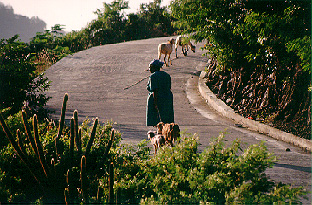 There are
interesting paintings of the Black Caribs' history in the old officers'
quarters. Fort Duvernette was built around 1800 on a massive rock 195 feet
above the sea to defend Calliaqua Bay. There are 24 pound guns and an
eight inch mortar. The hike up the fort is an old stone stairway that was
recently rebuilt by local stone masons. The view is great and the base
of the stairs is a short dinghy ride from our marina. The folks at
St. Vincent take good care of their animals. They are well fed
and seldom abused. It is not unusual to see domestic wildlife
wandering freely on the side of the road or tied to a stake in what appears
to be the middle of nowhere. We passed a woman with her family of
goats hiking up the road enjoying the view. A native man with his wife
were traveling up the road from Wallilabou when we met them under a tree
waiting for the rain to stop. He had three children and she one with
lots of close relatives. Each year they raise a cow or bull and they
keep it tied to a stake in the mountains. There are
interesting paintings of the Black Caribs' history in the old officers'
quarters. Fort Duvernette was built around 1800 on a massive rock 195 feet
above the sea to defend Calliaqua Bay. There are 24 pound guns and an
eight inch mortar. The hike up the fort is an old stone stairway that was
recently rebuilt by local stone masons. The view is great and the base
of the stairs is a short dinghy ride from our marina. The folks at
St. Vincent take good care of their animals. They are well fed
and seldom abused. It is not unusual to see domestic wildlife
wandering freely on the side of the road or tied to a stake in what appears
to be the middle of nowhere. We passed a woman with her family of
goats hiking up the road enjoying the view. A native man with his wife
were traveling up the road from Wallilabou when we met them under a tree
waiting for the rain to stop. He had three children and she one with
lots of close relatives. Each year they raise a cow or bull and they
keep it tied to a stake in the mountains. 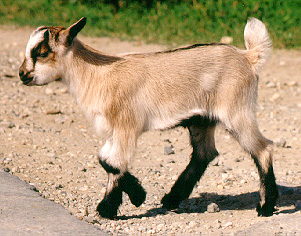 They are not worried about theft but
they do have to visit the animal regularly to move the stake and be sure
that it has the water and caring to survive. Each year at Christmas
they get their animal, walk it down the mountain, and it becomes their
Christmas dinner feeding their family and relatives for several
weeks. They said that cows are not a target for theft because an animal
that large would be difficult to hide. The thief would not want to be
seen taking the animal, slaughtering the animal, and then storing the large
amount of meat. Goats are more likely to be stolen than cows though
such a theft is seldom. Chickens are most likely to be a target of
theft more because of a mistake than of fowl play. Raising animals is
not very hard nor expensive and it does provide good nourishment in the
local diet. Goats are particularly easy to raise and they provide both milk
and meat. Livestock is becoming cheaper to purchase than fish
primarily because the local waters are becoming fished out so the fishermen
have to go to deeper waters. Another problem is a poison that is created by
local fish that eat the coral. This is poisonous to humans. They are not worried about theft but
they do have to visit the animal regularly to move the stake and be sure
that it has the water and caring to survive. Each year at Christmas
they get their animal, walk it down the mountain, and it becomes their
Christmas dinner feeding their family and relatives for several
weeks. They said that cows are not a target for theft because an animal
that large would be difficult to hide. The thief would not want to be
seen taking the animal, slaughtering the animal, and then storing the large
amount of meat. Goats are more likely to be stolen than cows though
such a theft is seldom. Chickens are most likely to be a target of
theft more because of a mistake than of fowl play. Raising animals is
not very hard nor expensive and it does provide good nourishment in the
local diet. Goats are particularly easy to raise and they provide both milk
and meat. Livestock is becoming cheaper to purchase than fish
primarily because the local waters are becoming fished out so the fishermen
have to go to deeper waters. Another problem is a poison that is created by
local fish that eat the coral. This is poisonous to humans. 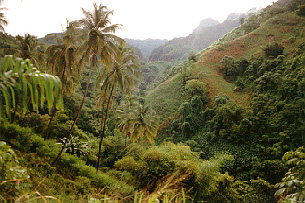 Consequently,
fishermen have to go to deeper waters to get the fish that do not feed off
the coral nor off fish that eat the other poisonous fish. Most of
the restaurants do not serve goat but do serve beef, chicken, and fish. Fish
is as expensive as beef though chicken is much less expensive. The chicken
in the islands are not plump and juicy as we have come to expect from our
tough Mr. Purdue. On the first day of the second week we sailed north along
the wester coast of St. Vincent to an anchorage that I had visited
twice before. Wallilabou has been a favorite anchorage enroute
from St. Lucia to the Grenadines because it is the right distance
between the two places. Another, and more important, reason is that there is
a great hike up a steep, twisty road through a rain forrest to the top of a
mountain about two from the bay. We met a couple who were hiking up the
mountain to tend to their livestock and we chatted under a tree while we
waited for the rain to stop. Consequently,
fishermen have to go to deeper waters to get the fish that do not feed off
the coral nor off fish that eat the other poisonous fish. Most of
the restaurants do not serve goat but do serve beef, chicken, and fish. Fish
is as expensive as beef though chicken is much less expensive. The chicken
in the islands are not plump and juicy as we have come to expect from our
tough Mr. Purdue. On the first day of the second week we sailed north along
the wester coast of St. Vincent to an anchorage that I had visited
twice before. Wallilabou has been a favorite anchorage enroute
from St. Lucia to the Grenadines because it is the right distance
between the two places. Another, and more important, reason is that there is
a great hike up a steep, twisty road through a rain forrest to the top of a
mountain about two from the bay. We met a couple who were hiking up the
mountain to tend to their livestock and we chatted under a tree while we
waited for the rain to stop. 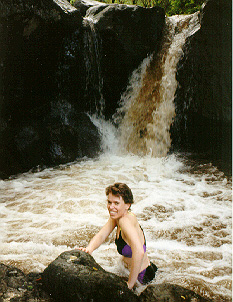 They
called it heavy morning dew. On the way back to our anchorage we stopped for
a quick dip in the river just below the waterfalls. Often, on a hot
day, the pool and waterfalls will be full of children playing. Below, near
the mouth of the river women wash their clothes on the rocks. They do not
like to have their picture taken. The moorings in the bay are very close
together and very deep. They are not far from shore and the locals are eager
to help you tie your stern to a tree to minimize the discomfort from the
swell. We found the bay to be rolly from the ocean swells and were
glad to get underway. Our next stop was for lunch at Cumberland Bay
which is particularly beautiful though shortly after we arrived clouds moved
in and it started to rain. The bay is surrounded by palm trees, tall hills,
and a valley that is picturesque. There were two morings in 100 feet of
water perhaps 100 feet off shore. It would be a difficult place to
anchor. After lunch, we headed south to Petit Byahaut. They
called it heavy morning dew. On the way back to our anchorage we stopped for
a quick dip in the river just below the waterfalls. Often, on a hot
day, the pool and waterfalls will be full of children playing. Below, near
the mouth of the river women wash their clothes on the rocks. They do not
like to have their picture taken. The moorings in the bay are very close
together and very deep. They are not far from shore and the locals are eager
to help you tie your stern to a tree to minimize the discomfort from the
swell. We found the bay to be rolly from the ocean swells and were
glad to get underway. Our next stop was for lunch at Cumberland Bay
which is particularly beautiful though shortly after we arrived clouds moved
in and it started to rain. The bay is surrounded by palm trees, tall hills,
and a valley that is picturesque. There were two morings in 100 feet of
water perhaps 100 feet off shore. It would be a difficult place to
anchor. After lunch, we headed south to Petit Byahaut.
Petit Byahaut
The beauty of Petit Byahaut was a great surprise and a pleasure to
discover. It was one of those quaint little places that did not have much
real-estate in the cruising guide and was not even mentioned during our
chart briefing. It was perhaps the only anchorage that sounded remotely
interesting as we headed back south towards Bequia. It turned out to be a
very well kept secret where we all rated the experience in the top ten in
all the Caribbean.
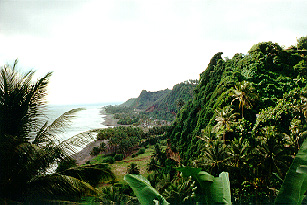 The major features include: The major features include:
- Beauty beyond imagination.
- The best snorkeling in the Caribbean.
- A five star restaurant with reasonable prices.
- The best organized hike this side of the equator.
The hike began with a short boat ride - they picked us up in a skiff and
took us to the neighboring bay where a taxi was waiting for us. Our ride to
the northeast part of the island took us through the botanical gardens,
along the coast through towns and plantations, and along the rugged east
coast with views of steep cliffs, thick vegetation, and the shore.We
stopped a few times to take pictures and get junk food to supplement our
healthy lunch prepared by Petit Byahaut chefs.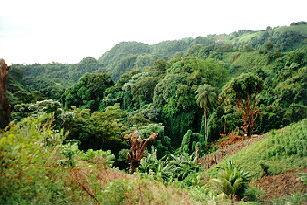 Our taxi took us to
the end of a road facing a towering volcano whose rim was obscured by
charging clouds heading west. The clouds seemed to come from nowhere
and encircled the volcano, dancing and playing with the sun. Casting
shadows and teasing us with a glimse of the majestic summit. We started
hiking through a thick jungle and rain forrest along a narrow but
well groomed trail. It was easy walking though a little muddy in
places. Areas of the trail were lined with thick green vegetation but
careful examination from time to time showed us to be on a narrow ridge that
fell sharply under the green carpet. One wrong step could ruin the day. We
hiked for a couple hours, an estimated 3.5 miles to get to the top. We
peered into the volcano culdera to see a very large crater.It was
steep. It was big. It got bigger as we started our journey around to the
other side. The depth was between 900 and 1500 feet depending on which part
of the rim you measured. We found a break from the wind and had lunch. It
was delicious. Our taxi took us to
the end of a road facing a towering volcano whose rim was obscured by
charging clouds heading west. The clouds seemed to come from nowhere
and encircled the volcano, dancing and playing with the sun. Casting
shadows and teasing us with a glimse of the majestic summit. We started
hiking through a thick jungle and rain forrest along a narrow but
well groomed trail. It was easy walking though a little muddy in
places. Areas of the trail were lined with thick green vegetation but
careful examination from time to time showed us to be on a narrow ridge that
fell sharply under the green carpet. One wrong step could ruin the day. We
hiked for a couple hours, an estimated 3.5 miles to get to the top. We
peered into the volcano culdera to see a very large crater.It was
steep. It was big. It got bigger as we started our journey around to the
other side. The depth was between 900 and 1500 feet depending on which part
of the rim you measured. We found a break from the wind and had lunch. It
was delicious. 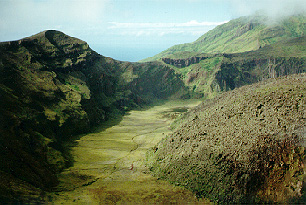 We became enveloped in a cloud. It got damp.
The sun came out. The clouds came. It drizzled. It stopped.
We started around the rim of the volcano. The trail was well
marked. The trail was easy hiking but steep in places with some loose
gravel. Not bad and we were making good time. When the sun was out,
the view was spiritual. Majestic. A reason to live. We hiked along what we
thought was so well marked that we wondered why we needed a guide. Then we
came to a fork. Several forks as we went along our way realizing that
a guide was good. Our guide told us the history of the land and of the
people who lived near the volcano. He told us a story of a man who went
crazy every full moon and would come up the volcanoe, climb into the crater,
and stay in a cave until after the full moon. He was afraid of what he would
do and how he would act around people when the moon approached fullness. He
said that there was a way down and a rope that was often used to assist in
the descent. When we were half way around the rim we came to the rope and
the way down. We became enveloped in a cloud. It got damp.
The sun came out. The clouds came. It drizzled. It stopped.
We started around the rim of the volcano. The trail was well
marked. The trail was easy hiking but steep in places with some loose
gravel. Not bad and we were making good time. When the sun was out,
the view was spiritual. Majestic. A reason to live. We hiked along what we
thought was so well marked that we wondered why we needed a guide. Then we
came to a fork. Several forks as we went along our way realizing that
a guide was good. Our guide told us the history of the land and of the
people who lived near the volcano. He told us a story of a man who went
crazy every full moon and would come up the volcanoe, climb into the crater,
and stay in a cave until after the full moon. He was afraid of what he would
do and how he would act around people when the moon approached fullness. He
said that there was a way down and a rope that was often used to assist in
the descent. When we were half way around the rim we came to the rope and
the way down.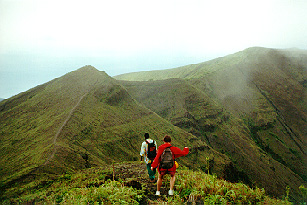 It appeared only a short distance down to the floor
of the culdera. Our guide almost ran down the inside of the volcano without
using the rope. He paused a few times to look back and provide
encouragement. A half hour later the smooth culdera floor appeared rugged
and full of huge bolders. Halte finished the descent and ran across the
floor like a child streaking across a lawn. At the center he waited by sulpher
steam emerging from white rocks. Moments later, when I arrived, the
smell became strong and the rocks were hot. We felt for the real hot ones,
looked at each other, said "cool," and headed back as the day was
getting late. We stopped by the legendary cave only to find it was a tiny
hole just big enough for a small human to wiggle through. The inside
appearance was like that of a bird's nest. It was clear that this was a
favorite place for Halte. He had only recently discovered the volcano hike
and had lead hikes for Petit Byahaut for the past three years. It appeared only a short distance down to the floor
of the culdera. Our guide almost ran down the inside of the volcano without
using the rope. He paused a few times to look back and provide
encouragement. A half hour later the smooth culdera floor appeared rugged
and full of huge bolders. Halte finished the descent and ran across the
floor like a child streaking across a lawn. At the center he waited by sulpher
steam emerging from white rocks. Moments later, when I arrived, the
smell became strong and the rocks were hot. We felt for the real hot ones,
looked at each other, said "cool," and headed back as the day was
getting late. We stopped by the legendary cave only to find it was a tiny
hole just big enough for a small human to wiggle through. The inside
appearance was like that of a bird's nest. It was clear that this was a
favorite place for Halte. He had only recently discovered the volcano hike
and had lead hikes for Petit Byahaut for the past three years. 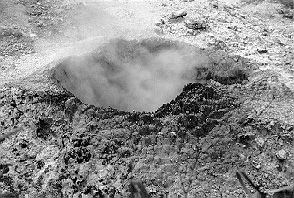 He
realized that he lived in a beautiful place and said that he did not
appreciate it as much as much as he should. He felt very fortunate to be
working for Charles at Petit Byahaut. It was time to proceed to our
rendezvous place on the beach and we had a long way to go. Back up the side
of the volcano we climbed. Halte almost ran up in a matter of minutes.
It took me about twice as long climbing the rope conveniently set
along the steep route. By the time I reached the rim I was sweatting and a
little tired. It was not a good idea to spend the day hiking in boat shoes
but they were doing pretty well so far. It was mid afternoon by now and we
were only about half way across. The views were still spectacular as we
headed down the trail through the rain forrest. As we got half way down, we
came across houses, gardens, and forrest. The trail was steep but well
maintained though a little muddy in places. We were lucky that we did
not encounter any serious rain. Halte stopped frequently to tell us about
the different plants and what their value was. He
realized that he lived in a beautiful place and said that he did not
appreciate it as much as much as he should. He felt very fortunate to be
working for Charles at Petit Byahaut. It was time to proceed to our
rendezvous place on the beach and we had a long way to go. Back up the side
of the volcano we climbed. Halte almost ran up in a matter of minutes.
It took me about twice as long climbing the rope conveniently set
along the steep route. By the time I reached the rim I was sweatting and a
little tired. It was not a good idea to spend the day hiking in boat shoes
but they were doing pretty well so far. It was mid afternoon by now and we
were only about half way across. The views were still spectacular as we
headed down the trail through the rain forrest. As we got half way down, we
came across houses, gardens, and forrest. The trail was steep but well
maintained though a little muddy in places. We were lucky that we did
not encounter any serious rain. Halte stopped frequently to tell us about
the different plants and what their value was. 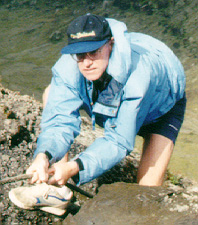 What was edible and what was poisonous. The gardens on steep
hills were good because the tender did not have to bend far to pull out
weeds. It was late afternoon and we still had a couple miles to
go. Halte talked, we walked, the coast got closer, and the sun
got lower. It set with a half mile to go and we made it to the coast before
dark. There was no boat. We searched. It got dark. No boat.
Darker. Started hiking. Found a guy with a pickup truck. And, the
adventure continued as we raced along the coast on the windy, steep road in
the back of a pickup truck. We arrived at a bay next to Petit Byahaut and
hiked through the woods along a trail ending at the restaurant. What was edible and what was poisonous. The gardens on steep
hills were good because the tender did not have to bend far to pull out
weeds. It was late afternoon and we still had a couple miles to
go. Halte talked, we walked, the coast got closer, and the sun
got lower. It set with a half mile to go and we made it to the coast before
dark. There was no boat. We searched. It got dark. No boat.
Darker. Started hiking. Found a guy with a pickup truck. And, the
adventure continued as we raced along the coast on the windy, steep road in
the back of a pickup truck. We arrived at a bay next to Petit Byahaut and
hiked through the woods along a trail ending at the restaurant.
In summary, the Grenadines and Petit Byahaut on St. Vincent is an
excellent vacation and should be repeated once every five years if not more
frequently. The boats were very comfortable and a pleasure to sail.
The highlights were the Tobago Cays and the volcano hike though every
day was exciting and pleasurable. Best of all, the people made the adventure
a trip to remember.

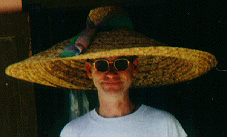 John Beckis an avid sailor and instructor with the
American Sailing Association (in addition to a "day" job).
During the year he leads several sailing flotillas and instructional
workshops throughout the world. He has a unique ability to blend in
with the natives so he is inconspicous and indistinguishable from the
local color. Over the past decade he has lead so many sailing trips in
the Caribbean that he considers the warm tropical waters his second
home. John Beckis an avid sailor and instructor with the
American Sailing Association (in addition to a "day" job).
During the year he leads several sailing flotillas and instructional
workshops throughout the world. He has a unique ability to blend in
with the natives so he is inconspicous and indistinguishable from the
local color. Over the past decade he has lead so many sailing trips in
the Caribbean that he considers the warm tropical waters his second
home. |
Bob Bell is a
seasoned sailor and all around great dude. He brought his family on
the sailing adventure and they were a lot of fun. Bob is certified
with the ASA and has spent many summer days sailing with his son Ian
back home in New Jersey. Together, they make an excellent
sailing team. Stepahnie was introduced to bareboat sailing and enjoyed
the lifestyle. Bob served during his week sailing as first mate
aboard Echo where he did an excellent job. |
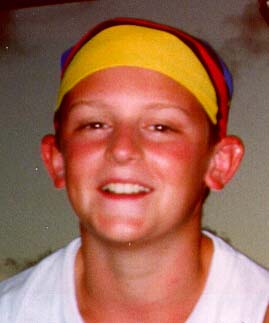 Ian
Bell is a sailor of small boats and this is the first time he has been
aboard a large sailing vessel. His first impression was that it was
cool. He participated in all the sailing activities and tried not to
miss any aspects of the adventure. By day three he had been
promoted from swaby to mate assuming additional responsibilities
aboard. Ian
Bell is a sailor of small boats and this is the first time he has been
aboard a large sailing vessel. His first impression was that it was
cool. He participated in all the sailing activities and tried not to
miss any aspects of the adventure. By day three he had been
promoted from swaby to mate assuming additional responsibilities
aboard. |
| Stephanie Bell is an
excellent cook and a first time bareboat sailor. She paitently
observed the activities each day and was quick to learn and contribute
to the daily operation of the boat. Our greatest pleasure was
Stephanie's most excellent culinary skills which we felt was an added
bonus. She was happy that Bob and Ian were involved in many activities
and enjoyed the peace and tranquility. |
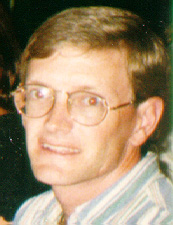 Norm Belson was new to bareboat sailing and he enjoyed
the lifestyle. His desire to sail was high and he was interested in
learning all he could. He adapted well to the nautical life and was
quite helpful. Norm Belson was new to bareboat sailing and he enjoyed
the lifestyle. His desire to sail was high and he was interested in
learning all he could. He adapted well to the nautical life and was
quite helpful. |
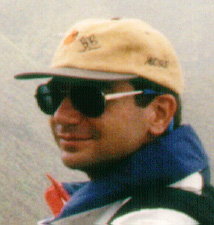 Bob Bennettis a seasoned sailor, boat owner, and good
friend. He has sailed the Caribbean as my first mate for many years.
We have enjoyed sailing the South Pacific islands of Bora Bora and
French Polynesia. His latest hobby is cooking aboard, especially
deserts. Bob Bennettis a seasoned sailor, boat owner, and good
friend. He has sailed the Caribbean as my first mate for many years.
We have enjoyed sailing the South Pacific islands of Bora Bora and
French Polynesia. His latest hobby is cooking aboard, especially
deserts. |
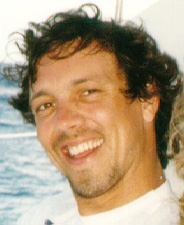 Brian Boyeris a great to have aboard. He has a high
aptitude for fun and was quick to get into the island life. He was
always ready to join any fun event and a great snorkeling companion.
This was his first sailing trip with the Adventure Club. Brian Boyeris a great to have aboard. He has a high
aptitude for fun and was quick to get into the island life. He was
always ready to join any fun event and a great snorkeling companion.
This was his first sailing trip with the Adventure Club. |
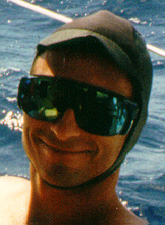 Michael Christoff enjoys the good life and
after two days in the Caribbean sun looks like a native. He likes to
be present for any and all fun activities on either of the boats. When
you are in need of a companion to snorkel or hike then you will find
Michael your friend. A party is not complete without Michael as he has
a magnetic personality. Michael Christoff enjoys the good life and
after two days in the Caribbean sun looks like a native. He likes to
be present for any and all fun activities on either of the boats. When
you are in need of a companion to snorkel or hike then you will find
Michael your friend. A party is not complete without Michael as he has
a magnetic personality. |
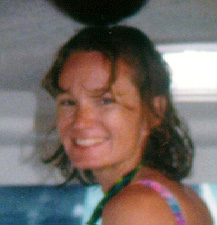 Diane Coogan is a natural sailor. A few weeks after
returning she went to Florida to get her ASA sailing certificate. She
is quite good at each of the many sailing stations and great fun to
have aboard. She enjoyed having a wind surfer aboard as the Grenadines
are a perfect place with perfect winds. Diane Coogan is a natural sailor. A few weeks after
returning she went to Florida to get her ASA sailing certificate. She
is quite good at each of the many sailing stations and great fun to
have aboard. She enjoyed having a wind surfer aboard as the Grenadines
are a perfect place with perfect winds. |
| Sharon DeVries
joined our sailing trip last November in the Caribbean where she
discovered the great lifestyle aboard and the strikingly beautiful
islands and cultures. She provides a unique perspective to the trip as
a trained psychologist and on several occasions helped with diagnosing
and treating locally acquired ailments. |
Martha Fratt has
been sailing for many years and had been aboard several sailing
adventures. She is quite good at each of the stations and helps make
life aboard a pleasure. In addition to water sports she enjoys
exploring the islands. Though I don't think she is a moring person,
she was always smiling and seemingly savoring every moment. |
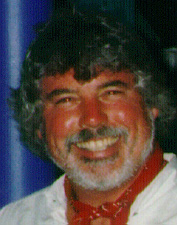 Tom Guthrie is an avid sailor and experienced skipper
specializing in sail trim. He likes to get up late, start slow, and
taper off. Tom is a very congenial host and likes his passengers to
relax and have a great time. In the afternoon you will likely find him
floating in the water after a hard sail with a cold umbrella drink
waiting by his towel. With the setting sun comes dinner and late night
partying, dancing, and carrying on. Tom Guthrie is an avid sailor and experienced skipper
specializing in sail trim. He likes to get up late, start slow, and
taper off. Tom is a very congenial host and likes his passengers to
relax and have a great time. In the afternoon you will likely find him
floating in the water after a hard sail with a cold umbrella drink
waiting by his towel. With the setting sun comes dinner and late night
partying, dancing, and carrying on. |
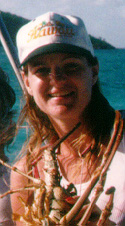 Laura Herkert... No sailing trip is complete without
Laura. She loves the sun, sea, and islands; appreciates excellent
food, weather, and people; and, is always ready for adventure -
swimming, hiking, sailing, you name it. She is great help aboard and
is a inspirational person. Laura Herkert... No sailing trip is complete without
Laura. She loves the sun, sea, and islands; appreciates excellent
food, weather, and people; and, is always ready for adventure -
swimming, hiking, sailing, you name it. She is great help aboard and
is a inspirational person. |
Cindy Humphrey
enjoys the good life aboard. |
Stan King has been
on many sailing trips and is becoming quite knowledgable about the
many Caribbean islands. He has developed very good navigational skills
as well as a good general nautical knowledge and is well respected in
sailing circles. That's when you end your sail at the same place you
start. Stan also has a well developed sense of nautical humor. |
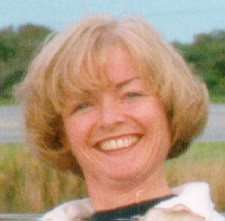 Cathy Lavelle first boarded a boat and also first
experienced the South Pacific islands on this trip. She was amazed at
the beauty of the islands, the comfort aboard the boat, and the
company of the other crew members. She immediately made friends with
everyone and helped make life aboard a special experience. Cathy Lavelle first boarded a boat and also first
experienced the South Pacific islands on this trip. She was amazed at
the beauty of the islands, the comfort aboard the boat, and the
company of the other crew members. She immediately made friends with
everyone and helped make life aboard a special experience. |
Mike McCarthy is a
very talented photographer and a great companion for exploring
islands. He has a unique way of looking at things through the lense of
a camera and though we went to many of the same places and saw many of
the same things, the images that he captured highlighted our
experience with a wonderful perspective. It was a special experience
having Mike aboard as we have always enjoyed our sails together. |
Rachelle McCarthy is
a great help aboard and enjoys sailing. She is very organized,
knowledgable, and skilled in all aspects of sailing. Combined with her
leadership skills she will likely continue training and perhaps
someday be a skipper. |
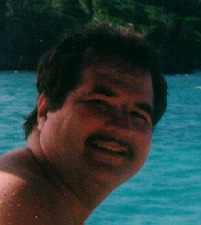 Bill McGinniss is an all around fun guy who could easily
be mistaken for a yachtie. As the plane touched down in the sunny
Caribbean he instantly went into island mode keeping pace with the
natives. He enjoys the balance of sailing, exploring, dining, and
socializing. Party on, dude! Bill McGinniss is an all around fun guy who could easily
be mistaken for a yachtie. As the plane touched down in the sunny
Caribbean he instantly went into island mode keeping pace with the
natives. He enjoys the balance of sailing, exploring, dining, and
socializing. Party on, dude! |
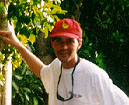 Tom McLoughlin is an excellent sailor and first mate. He
is skilled in all aspects of sailing and has a talent for teaching and
helping others to understand and master the basics of sailing. His
love for racing sailboats makes life aboard extra special as he has an
excellent perspective and lively sense of humor. Tom McLoughlin is an excellent sailor and first mate. He
is skilled in all aspects of sailing and has a talent for teaching and
helping others to understand and master the basics of sailing. His
love for racing sailboats makes life aboard extra special as he has an
excellent perspective and lively sense of humor. |
Joan Most is a world
traveller and greatly enjoys the thrill of sailing. In contrast to the
busy life on Wall Street, the peace and tranquility of the islands are
very attractive. She is learning the ropes and is an experienced
traveller. |
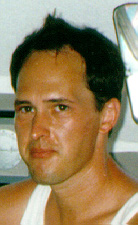 Jeff Parrish is an accomplished traveller and cultivates
a healthy passion for adventure. He joined our Arctic expedition in
August and can now compare with the sunny Caribbean islands in a sea
of turquoise wonder. In August we drank tea in the midnight sun,
watched the icebergs float buy, and discussed the details of our
sailing trip. Aboard our yacht, we discussed the awesome and
incredible hikes in a land far north and beyond the imagination of
those here. Jeff is a quick study of sailing and will be a valuable
asset and perhaps skipper to compliment his adventurous lifestyle. Jeff Parrish is an accomplished traveller and cultivates
a healthy passion for adventure. He joined our Arctic expedition in
August and can now compare with the sunny Caribbean islands in a sea
of turquoise wonder. In August we drank tea in the midnight sun,
watched the icebergs float buy, and discussed the details of our
sailing trip. Aboard our yacht, we discussed the awesome and
incredible hikes in a land far north and beyond the imagination of
those here. Jeff is a quick study of sailing and will be a valuable
asset and perhaps skipper to compliment his adventurous lifestyle. |
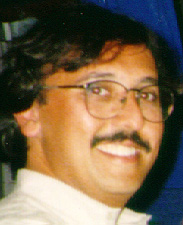 Nabi Rafie has a natural talent for sailing and is very
skilled in all aspects of the seamanship and was an excellent first
mate aboard Doug's boat. In addition to helping provide safe passage,
he kept their boat organized and helped plan and lead many of the
adventures ashore and in the water. He is a pleasure aboard and an
excellent travelling companion. An added bonus is his culinary skills
making him a well rounded, world-class sailor. Nabi has sailed as
first mate on many exotic trips and will soon be a skipper. Nabi Rafie has a natural talent for sailing and is very
skilled in all aspects of the seamanship and was an excellent first
mate aboard Doug's boat. In addition to helping provide safe passage,
he kept their boat organized and helped plan and lead many of the
adventures ashore and in the water. He is a pleasure aboard and an
excellent travelling companion. An added bonus is his culinary skills
making him a well rounded, world-class sailor. Nabi has sailed as
first mate on many exotic trips and will soon be a skipper. |
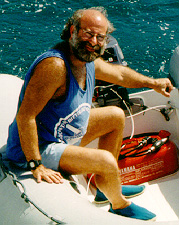 Doug Rapkine
is an excellent sailor, boat owner, and skipper whose enthusiasm and
helpfulness defines the standard for all. He is an expert at all
aspects of sailing, loves water sorts (especially wind surfing and
scuba diving), and is always a great adventure companion - a true
pleasure to sail with. Doug is up at sunrise swimming and does not
miss any opportunity for fun or to lend a hand. He believes that you
can sleep when you are dead and that when on vacation it is a good
idea to do capture pleasurable experiences. Doug Rapkine
is an excellent sailor, boat owner, and skipper whose enthusiasm and
helpfulness defines the standard for all. He is an expert at all
aspects of sailing, loves water sorts (especially wind surfing and
scuba diving), and is always a great adventure companion - a true
pleasure to sail with. Doug is up at sunrise swimming and does not
miss any opportunity for fun or to lend a hand. He believes that you
can sleep when you are dead and that when on vacation it is a good
idea to do capture pleasurable experiences. |
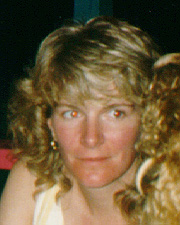 Amy Taylor joined the Adventure Club for
the first time on this trip and was enthusiastic about all of the
activities both aboard, ashore, and in the water. It was great to
share the living experience and sailing adventure with her as she and
Brian were perfect for the trip. Amy Taylor joined the Adventure Club for
the first time on this trip and was enthusiastic about all of the
activities both aboard, ashore, and in the water. It was great to
share the living experience and sailing adventure with her as she and
Brian were perfect for the trip. |
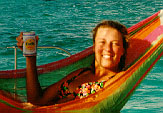 Dionne Wenke is a perfect adventurer who is easy going
and lots of fun. She enjoyed the sailing experience as much as the
adventures ashore. In addition to being in excellent physical shape,
she is enthusiastic about exploring, hiking, swimming, snorkeling,
sailing, and just about everything. Dionne Wenke is a perfect adventurer who is easy going
and lots of fun. She enjoyed the sailing experience as much as the
adventures ashore. In addition to being in excellent physical shape,
she is enthusiastic about exploring, hiking, swimming, snorkeling,
sailing, and just about everything. |
|
See also Captain's Log and tips for future sailing plans. The missing crew of the
Second Week were found, the boat in perfect shape, and they are planning
their next adventure.
|
